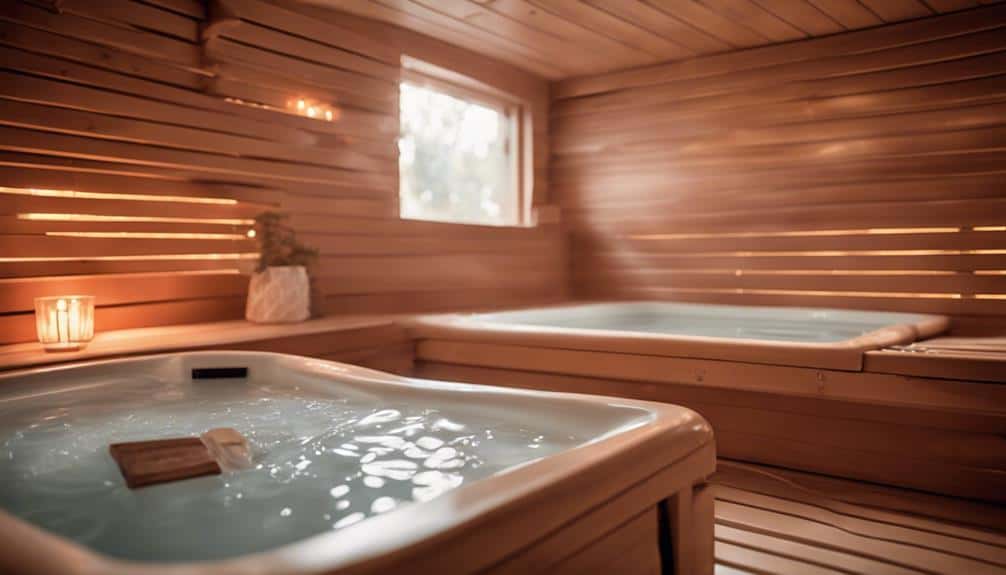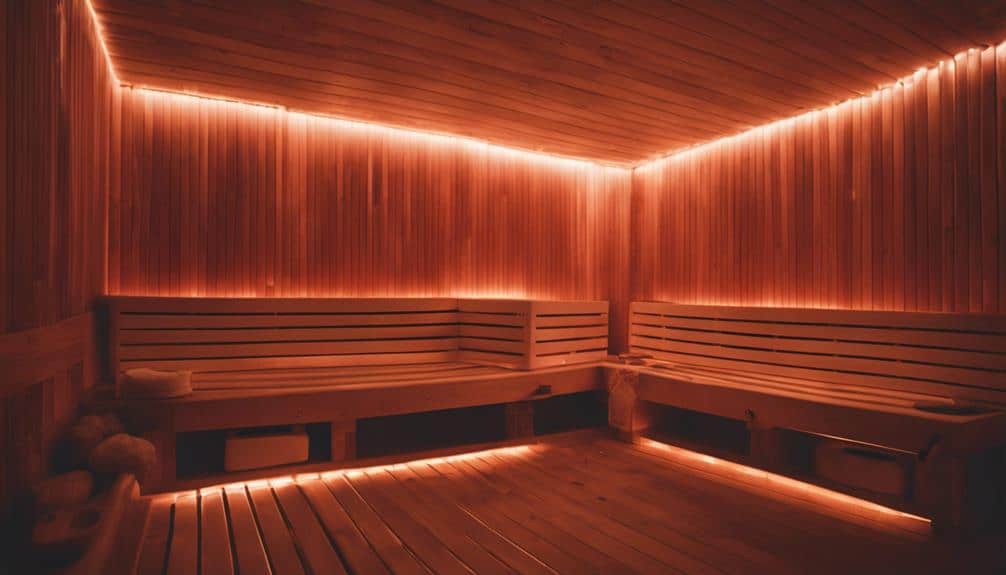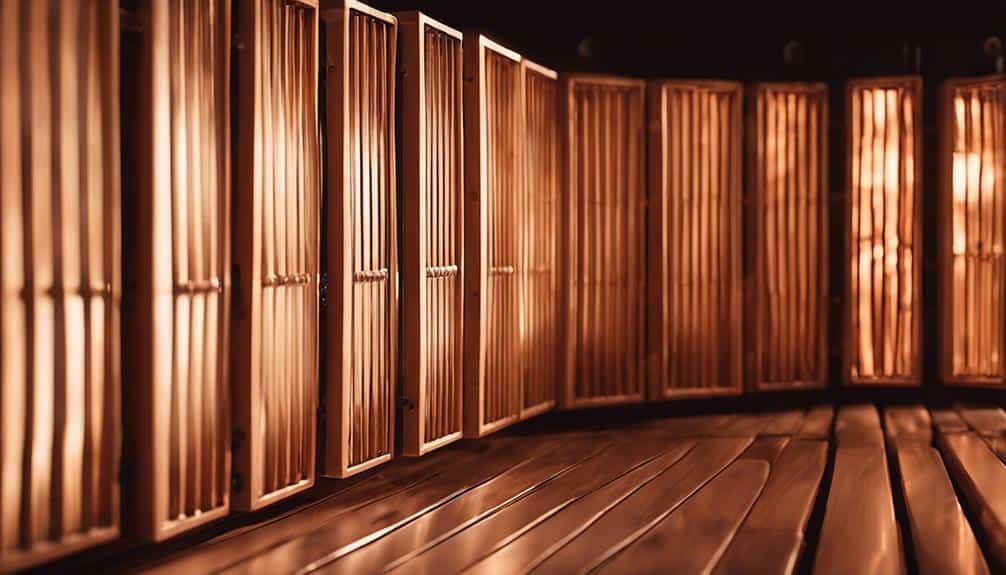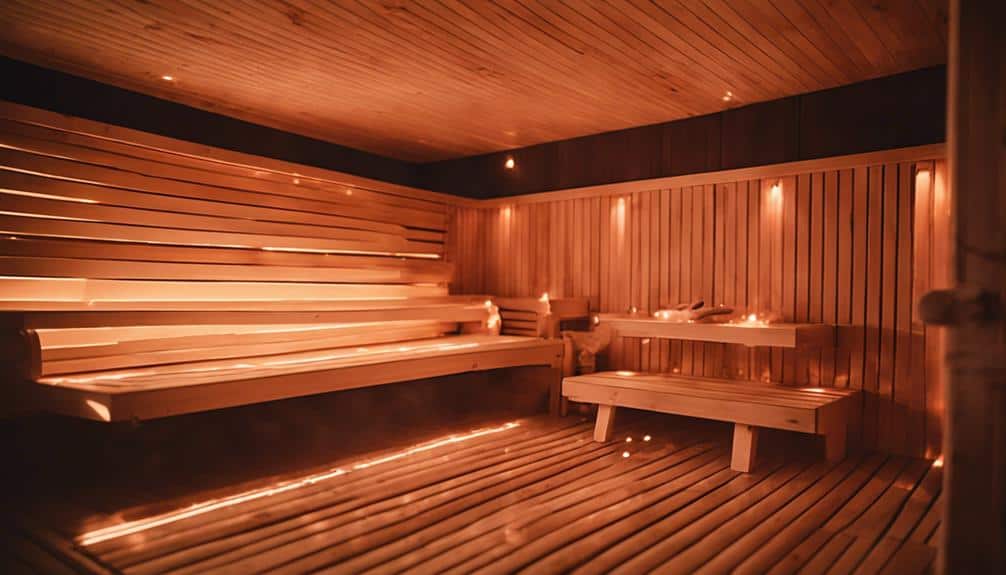Carbon Vs Ceramic Infrared Sauna
As I stepped into the infrared sauna, the warmth enveloped me, providing instant relaxation and rejuvenation. But as I explored the world of infrared saunas, I couldn't help but wonder: carbon or ceramic? Which one would truly offer the ultimate sauna experience?
The debate between carbon and ceramic infrared saunas has been a topic of discussion among sauna enthusiasts, and with good reason. Both options have their merits and drawbacks, making it essential to understand the key differences and benefits to make an informed decision.
So, let's delve into the world of carbon vs ceramic infrared saunas and discover which one reigns supreme.
Key Takeaways
- Carbon saunas offer even heat distribution and deeper detoxification, while ceramic saunas have high emissivity for quick warm-up times.
- Carbon saunas are energy-efficient and have a longer lifespan, while ceramic saunas are cost-effective and durable.
- Carbon saunas are suitable for heat-sensitive individuals, while ceramic saunas promote improved blood circulation and relaxation.
- Ceramic saunas have an easy installation process, low maintenance requirements, and are eco-friendly with reduced electricity consumption.
Carbon Infrared Sauna Benefits
Carbon infrared saunas offer a multitude of benefits that make them a popular choice for individuals seeking a comfortable and effective sauna experience. One of the key advantages of carbon infrared saunas is the use of carbon heaters. These heaters are designed to provide even heat distribution, ensuring that there are no hot or cold spots within the sauna. This even heat allows for a more enjoyable and relaxing sauna session, as you can be confident that every part of your body is receiving the same level of warmth.
The health benefits of carbon infrared saunas are another reason why they're highly favored. The penetrating heat produced by carbon heaters can reach deeper into the skin compared to other types of saunas. This deeper heat penetration allows for a more thorough detoxification process, as it helps to stimulate sweat production and release toxins from the body. Additionally, carbon infrared saunas operate at lower temperatures compared to traditional saunas, reducing the risk of heat-related health issues. This makes them a safer option for individuals who are conscious of their health.
Furthermore, carbon heaters in infrared saunas are known for their durability and energy efficiency. These panels have a longer lifespan compared to ceramic heaters, lasting up to 100,000 hours. This not only ensures prolonged use but also reduces the need for frequent replacements, leading to lower operation costs over time.
Ceramic Infrared Sauna Benefits

Ceramic infrared saunas offer a range of benefits that make them a popular choice for individuals seeking an efficient and invigorating sauna experience. Here are some key advantages of ceramic infrared saunas:
- High Emissivity: Ceramic heaters in infrared saunas have high emissivity, which means they efficiently transfer heat to the body. This allows for a more effective and satisfying sauna session, as the heat penetrates deeply into the muscles and tissues.
- Cost-effectiveness: Ceramic heaters are known for their cost-effectiveness. They're commonly found in traditional infrared sauna setups and provide a reliable and durable heating source. With their longer lifespan compared to other types of heaters, ceramic infrared saunas offer a great investment in the long run.
- Quick Warm-up Times: One of the notable benefits of ceramic heaters is their quick warm-up times. They heat up rapidly, allowing users to experience the desired sauna temperature without waiting for a long time. This is particularly beneficial for those who want immediate heat and prefer not to waste time.
- Promotes Sweating and Detoxification: The intense heat produced by ceramic heaters can help promote sweating and detoxification during sauna sessions. Sweating is a natural way for the body to eliminate toxins and impurities, and ceramic infrared saunas facilitate this process effectively.
Heating Efficiency Comparison

When comparing the heating efficiency of infrared saunas, it's important to consider various factors such as heat distribution, energy efficiency, longevity, and health benefits.
In terms of heat distribution, carbon heaters in infrared saunas offer superior performance compared to ceramic heaters. Carbon heaters provide even heat distribution throughout the sauna, ensuring that every corner receives the same amount of warmth. On the other hand, ceramic heaters may have hotspots and uneven heating, which can result in discomfort during sauna sessions.
In terms of energy efficiency, carbon heaters are the clear winner. They're more energy efficient and reach the necessary temperatures faster, saving both time and money compared to ceramic heaters. This makes carbon heaters a more practical choice for those who want to enjoy the benefits of infrared heat without wasting excessive energy.
Furthermore, carbon heaters have a longer lifespan compared to ceramic heaters. Carbon heaters can last up to 100,000 hours, while ceramic heaters tend to deteriorate after around 5,000 hours of use. This longevity factor makes carbon heaters a more cost-effective option in the long run.
Lastly, carbon heaters reduce health risks associated with high temperatures, making longer and safer sauna sessions possible. Ceramic heaters can emit high temperatures that may lead to health problems such as dehydration and overheating. In contrast, carbon heaters provide a more gentle and comfortable heat, minimizing the risk of such health issues.
Considering all these factors, it's evident that carbon heaters are the superior choice for those seeking an energy-efficient and health-focused infrared sauna experience.
Durability and Longevity

Durability and longevity are important considerations when choosing an infrared sauna, and carbon fiber heaters excel in these areas. Here are four key reasons why carbon heaters are known for their durability:
- Robust Construction: Carbon fiber infrared sauna heaters are exceptionally durable, thanks to their robust construction. Made from 100% carbon sheet, these heaters are resistant to cracking and shattering, ensuring long-term performance.
- High-Temperature Performance: Carbon fiber heaters perform well under high temperatures, maintaining their quality and efficiency over time. They're designed to withstand the intense heat generated in saunas, ensuring longevity even with prolonged use.
- Resistance to Deterioration: Unlike ceramic heaters, which are fragile and prone to deterioration, carbon fiber heaters are built to last. They aren't only resistant to physical damage but also less likely to degrade with repeated use.
- Reliable Suppliers: Trusted suppliers like JNH Lifestyles offer carbon fiber heaters known for their longevity and durability. With their high-quality construction and materials, these heaters provide a reliable and long-lasting sauna experience.
Choosing a sauna with durable and long-lasting heaters is essential for a worthwhile investment. Carbon fiber infrared sauna heaters, with their robust construction, high-temperature performance, resistance to deterioration, and reliable suppliers, offer superior durability and longevity compared to ceramic heaters.
Health Benefits of Carbon Saunas

Carbon saunas offer a multitude of health benefits that make them an excellent choice for individuals seeking a safe and effective way to improve their well-being. These saunas use carbon fiber infrared sauna heaters, which operate at lower temperatures and produce longer wavelengths compared to ceramic saunas. This lower operating temperature reduces the risk of heat-associated health problems, making carbon saunas a safer option for longer sauna sessions.
One of the key advantages of carbon saunas is their ability to provide even heat distribution throughout the sauna cabin. This allows for deeper detoxification and more efficient sweating. As a result, users experience cleaner sweat and more effective heating compared to ceramic saunas.
The gentle and tolerable heat of carbon saunas makes them suitable for individuals who want to reap the health benefits without subjecting themselves to extreme temperatures. This makes carbon saunas ideal for those with heat sensitivity or medical conditions that prevent them from tolerating high temperatures.
Health Benefits of Ceramic Saunas

Ceramic saunas offer a range of health benefits that can contribute to overall well-being and promote various aspects of physical and mental wellness. These saunas utilize infrared technology to generate heat, which is then distributed evenly throughout the sauna. The infrared heat penetrates deep into the body, providing a multitude of benefits.
- Improved blood circulation and cardiovascular health: The intense heat in ceramic saunas can help dilate blood vessels, leading to improved circulation. This can enhance cardiovascular function and support heart health.
- Relaxation and stress relief: The high temperatures in ceramic saunas induce a deep sweat, promoting relaxation and stress relief. This can help alleviate tension and promote a sense of calm and well-being.
- Muscle recovery and reduced soreness: Ceramic saunas are popular for their ability to aid in muscle recovery. The heat helps to increase blood flow to the muscles, reducing tension and soreness after physical activity.
- Enhanced skin health: The heat from ceramic saunas opens up pores, promoting detoxification and improving skin tone. Regular sauna sessions can also help to eliminate toxins from the body, resulting in healthier-looking skin.
Frequently Asked Questions
Are Carbon or Ceramic Heaters Better in a Sauna?
I believe carbon heaters are better in a sauna. They offer efficient heat distribution, reducing hotspots and providing a more comfortable experience. Carbon saunas are also known for their health benefits and cost-effectiveness compared to ceramic saunas.
What Is the Best Material for an Infrared Sauna?
The best material for an infrared sauna is carbon. Carbon heaters offer efficient heat distribution, durability, and low maintenance. They are more effective at heating the body directly, providing a comfortable sauna experience.
What Is the Best Heating Element Infrared Sauna?
In my opinion, the best heating element for an infrared sauna is carbon. Carbon heaters provide numerous benefits, such as reduced health risks, deeper detoxification, even heat distribution, energy efficiency, and durability compared to ceramic heaters.
What Are the Benefits of a Ceramic Sauna?
The benefits of a ceramic sauna include quick heat-up time, cost-effectiveness, intense heat for a more intense sweating experience, longer lifespan, and efficient heat distribution. Compared to carbon saunas, ceramic infrared saunas offer these advantages.
Conclusion
In conclusion, when it comes to choosing between carbon and ceramic infrared saunas, the advantages of carbon heaters are clear.
Like a gentle breeze that permeates every corner of a serene garden, carbon heaters distribute heat evenly, providing effective detoxification and a more energy-efficient experience.
They're like a sturdy oak tree, standing the test of time with their durability and longer lifespan.
Carbon saunas offer a gentle, yet powerful, heat that nurtures overall well-being and leaves you feeling refreshed and rejuvenated.







